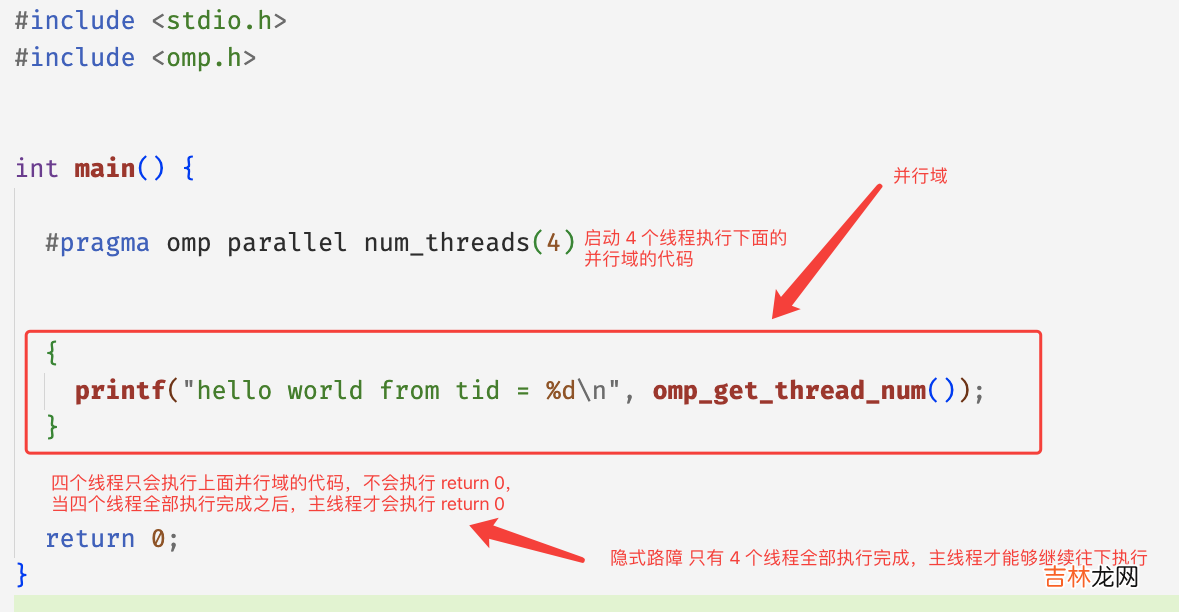OpenMP 入门简介OpenMP 一个非常易用的共享内存的并行编程框架,它提供了一些非常简单易用的API,让编程人员从复杂的并发编程当中释放出来,专注于具体功能的实现 。openmp 主要是通过编译指导语句以及他的动态运行时库实现,在本篇文章当中我们主要介绍 openmp 一些入门的简单指令的使用 。
认识 openmp 的简单易用性比如现在我们有一个任务,启动四个线程打印 hello world,我们看看下面 C 使用 pthread 的实现以及 C++ 使用标准库的实现,并对比他们和openmp 的实现复杂性 。
C 语言实现#include <stdio.h>#include <pthread.h>void* func(void* args) {printf("hello world from tid = %ld\n", pthread_self());return NULL;}int main() {pthread_t threads[4];for(int i = 0; i < 4; i++) {pthread_create(&threads[i], NULL, func, NULL);}for(int i = 0; i < 4; i++) {pthread_join(threads[i], NULL);}return 0;}上面文件编译命令:gcc 文件名 -lpthread。
C++ 实现#include <thread>#include <iostream>void* func() {printf("hello world from %ld\n", std::this_thread::get_id());return 0;}int main() {std::thread threads[4];for(auto &t : threads) {t = std::thread(func);}for(auto &t : threads) {t.join();}return EXIT_SUCCESS;}上面文件编译命令:g++ 文件名 lpthread。
OpenMP 实现#include <stdio.h>#include <omp.h>int main() {// #pragma 表示这是编译指导语句 表示编译器需要对下面的并行域进行特殊处理 omp parallel 表示下面的代码区域 {} 是一个并行域 num_threads(4) 表示一共有 4 个线程执行 {} 内的代码 因此实现的效果和上面的效果是一致的#pragma omp parallel num_threads(4){printf("hello world from tid = %d\n", omp_get_thread_num()); // omp_get_thread_num 表示得到线程的线程 id}return 0;}上面文件编译命令:gcc 文件名 -fopenmp,如果你使用了 openmp 的编译指导语句的话需要在编译选项上加上 -fopenmp 。
从上面的代码来看,确实 openmp 写并发程序的复杂度确实比 pthread 和 C++ 低 。openmp 相比起其他构建并行程序的方式来说,使用 openmp 你可以更加关注具体的业务实现,而不用太关心并发程序背后的启动与结束的过程,OenpMP 会帮我们实现很多细节,让程序的执行符合我们的直觉 。
opnemp 基本原理在上文当中我们写了一个非常简单的 openmp 程序,使用 4 个不同的线程分别打印 hello world。我们仔细分析一下这个程序的执行流程:

文章插图
在 openmp 的程序当中,你可以将程序用一个个的并行域分开,在并行域(parallel region)中,程序是有并发的,但是在并行域之外是没有并发的,只有主线程(master)在执行,整个过程如下图所示:

文章插图
现在我们用一个程序去验证上面的过程:
#include <stdio.h>#include <omp.h>#include <unistd.h>int main() {#pragma omp parallel num_threads(4){printf("parallel region 1 thread id = %d\n", omp_get_thread_num());sleep(1);}printf("after parallel region 1 thread id = %d\n", omp_get_thread_num());#pragma omp parallel num_threads(4){printf("parallel region 2 thread id = %d\n", omp_get_thread_num());sleep(1);}printf("after parallel region 2 thread id = %d\n", omp_get_thread_num());#pragma omp parallel num_threads(4){printf("parallel region 3 thread id = %d\n", omp_get_thread_num());sleep(1);}printf("after parallel region 3 thread id = %d\n", omp_get_thread_num());return 0;}程序执行之后的一种输出(还有很多其他的输出形式,因为是多线程程序,线程的输出是不确定的)如下所示:
经验总结扩展阅读
- 牛客 python试题解析1 - 入门级
- steam饥荒咋玩(steam饥荒入门教学)
- Types Info Subsystem XAF新手入门 - 类型子系统
- Netty学习记录-入门篇
- 一篇文章带你了解轻量级Web服务器——Nginx简单入门
- 【一】ERNIE:飞桨开源开发套件,入门学习,看看行业顶尖持续学习语义理解框架,如何取得世界多个实战的SOTA效果?
- Module XAF新手入门 - 模块
- 一篇文章带你了解NoSql数据库——Redis简单入门
- C# RulesEngine 规则引擎:从入门到看懵
- 3 Python全栈工程师之从网页搭建入门到Flask全栈项目实战 - 入门Flask微框架














